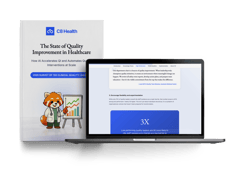
5 Key Drivers of Patient Satisfaction in Healthcare
Patient satisfaction is at the heart of healthcare. Yet, worryingly, over half of Americans don't rate their healthcare above 'fair'. This dip in trust affects patient experiences and satisfaction levels.
The message is clear: healthcare providers need to step up. By prioritizing patient satisfaction and improving services, you can regain trust, boost patient loyalty, and enhance your reputation in the healthcare world.
Meet the Expert
Mical DeBrow is an accomplished healthcare leader and clinician with extensive expertise spanning pharma, healthcare payers and providers, and healthcare information technology.
Why Patient Satisfaction Matters
Happy patients are the lifeblood of any healthcare practice. They're more likely to stick with their providers, follow treatment plans, and even recommend others. But it's not just about loyalty-patient satisfaction is a cornerstone of quality care.
So, it's not just about patients needing healthcare services. It's about healthcare services needing satisfied patients. After all, they're the ones who seek out and use these services. Prioritizing their satisfaction isn't just good practice, it's essential for success.
» Looking to enhance patient care? Check out how access to best practices can benefit patient outcomes.
1. Clear Communication with Patients and Providers
It's important that everyone--from patients to doctors, nurses, and the entire care team --is on the same page about a patient's condition, treatment plan, and any health changes. That comes down to slick, coordinated care through communication.
But it's not just about sharing information. It's about active engagement. Patients need to feel heard, not sidelined by providers distracted with inputting information into electronic health records.
Take this example: during a team round, the team spotted early signs of a patient's health deteriorating. Because they communicated effectively, they acted fast and saved a life. That's the power of good communication.
But when communication fails, things can go wrong. Like when a cardiologist didn't update a patient about a delay in their procedure. The patient became so anxious and agitated they needed sedation. If there had been clear, timely communication, this could have been avoided.
New tools are helping clinicians communicate faster and more effectively. Watch our latest webinar to learn more.
Good communication can prevent complications, improve medication adherence, and boost patient satisfaction. It's not just best practice-it's essential.
» Explore the types of health information technology and their uses.
2. Timely and Effective Pain Management
Managing pain isn't just about responding to requests for medication. It's about staying one step ahead, preventing unnecessary suffering, and promoting healing.
Proactive pain management showing patients we're competent and compassionate. We do this by
- Regularly assessing pain levels.
- Administering medications appropriately.
- Utilizing alternative pain therapies as needed.
- Avoiding opioids when possible.
- Setting realistic pain goals.
When we drop the ball on pain management, it hurts patient trust. If patients are left in pain for too long, or if they expect to be completely pain-free, they start to lose faith in their care team.
But when we're quick to respond to pain and anticipate it, patients feel looked after, especially when they're at their most vulnerable. This then improves their overall satisfaction.
» Want quick and easy access vetted medication guidance? Check out C8Health.
3. Understanding Medication Regimens
Prescribing medication plays an essential role in patient treatment. It can help manage and cure diseases, alleviate symptoms, and improve overall well-being.
But it's not just about writing a prescription and sending the patient on their way.
We need to give patients clear and concise information about their medications, dosages, and potential side effects.
This approach helps them understand their treatment plan better and stick to their prescribed medications. The result? Better health outcomes, lower healthcare costs due to fewer readmissions, and increased patient satisfaction.
But what happens when patients don't understand their medications? They might dose incorrectly, interact with contraindicated drugs, or fail to recognize adverse reactions. This confusion can lead to non-adherence and dissatisfaction.
So, let's turn this around. When we take the time to make sure patients fully understand their medication regimens, we see better adherence and higher satisfaction. How do we do this?
- We use layman's terms.
- Explain the instructions step-by-step.
- Have patients teach back what they've learned.
- Print instructions to help recollection.
- Follow-up calls to reinforce guidance and answer questions.
» Check out more ways to reduce costs in healthcare.
4. Cleanliness of Facilities
Cleanliness in healthcare minimizes infection risks, ensures comfort for patients and their families, and upholds patient satisfaction. When cleanliness is compromised, it can lead to health hazards and a decline in patient satisfaction. So, cleanliness is an integral part of risk management in healthcare quality.
While cleanliness might not be directly linked to clinical care, it significantly influences patient satisfaction. Picture a patient in a dirty room or bathroom, navigating cluttered hallways, or surrounded by uninspiring decor. Such an environment isn't conducive to healing.
To ensure a healing environment, consider aesthetics and infection control including:
- Regularly changing and washing linens and gowns to maintain freshness.
- Rigorous disinfection of facilities to prevent the spread of infections.
- Minimizing noise levels promotes restful sleep and aids in recovery.
The care environment reflects the quality of care in patients' eyes. Unclean or chaotic facilities communicate neglect, while comfortable, sanitized settings aid healing.
5. Clear Discharge Instructions
The discharge process is a key part of a patient's healthcare journey. It gives them the know-how they need for taking care of themselves after they leave the hospital. This not only helps cut down on readmission rates but also gives patients the confidence to manage their care at home. Patients need to leave the hospital with clear instructions., including:
- Their diagnosis
- When their follow-up appointments are
- Any changes to their medication
- Signs of complications they should watch out for
- Who to contact with questions
If a patient leaves the hospital feeling confused or runs into complications, it's a sign that communication during their stay could have been better.
To avoid this, providers need to make sure they're giving a clear and thorough explanation of the discharge plans. They should provide printed instructions for patients to take home, make follow-up phone calls, and coordinate with outpatient care providers.
When patients leave the hospital with a clear understanding of how to look after themselves, they're more likely to have better outcomes and higher satisfaction levels.
» Find out how to identify gaps in healthcare and close them.
The Key is Patient-Centered Care
Patient-centered care is the key to providing a great patient experience. Patients want to be heard, understood, and treated as active partners in their care. Building meaningful relationships with patients takes time, but small acts of empathy can make a big difference.
All healthcare providers should prioritize the patient's needs, not just physicians. While technology and medical knowledge are important, they should not replace the human touch in the care of patients. The human element remains essential in healing.
Even as healthcare becomes more advanced and complicated, it is important to remember that the human connection between healthcare providers and patients is still crucial in healing.


